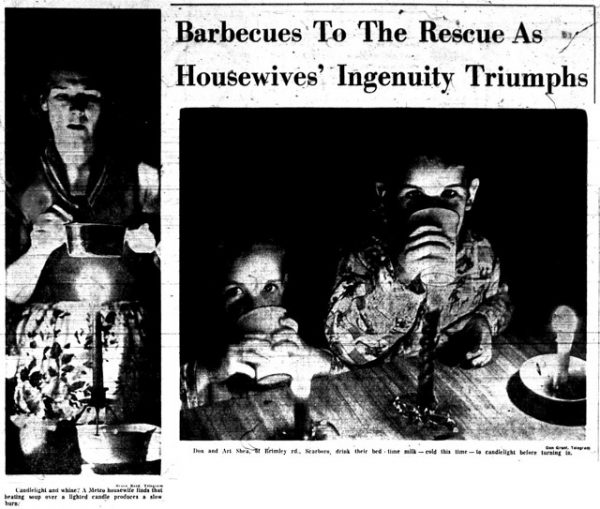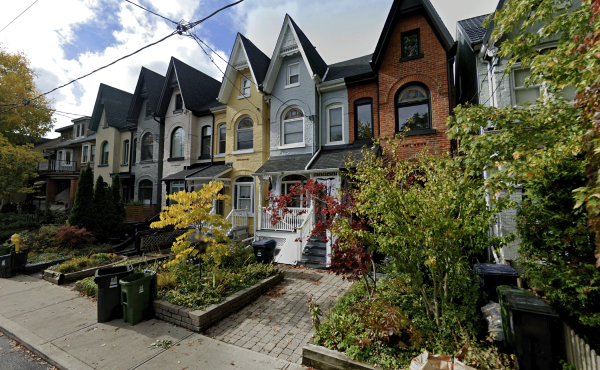August 14 marks the 20th anniversary of the Northeast Blackout of 2003, which is estimated to have affected over 50 million people in Ontario and eight American states. It remains the largest power outage in North American history. While electricity was restored to many areas within hours, parts of Toronto waited several days for the juice to flow again. The city experienced everything from rescues of people stuck in elevators and the subway to neighbourhoods turning into party zones.
Nearly 40 years earlier, many of the same parts of Ontario experienced the Great Northeast Blackout of 1965. The following story, originally published by Torontoist on April 14, 2012, looks at how Torontonians managed, and even enjoyed, what remains North America’s second largest blackout ever.
Mass power outages can make the imagination run wild. Take the case of Mrs. Joe Clarke, who was driving through downtown Toronto during the Great Northeast Blackout of 1965. According to the Telegram, Mrs. Clarke “got the fright of her life when she saw a shadowy monster silhouetted in the moonlight.” After a moment of panic, she realized that she wasn’t in a horror film: “the terrified woman realized that the lurking broad-shouldered ‘creature’ was…the Royal York Hotel.”
Despite the occasional person envisioning city landmarks as Japanese movie monsters and passing thoughts that saboteurs were at work, Torontonians took the blackout that struck the city during rush hour on November 9, 1965 in stride. While the power outage didn’t leave as large an impact on Toronto as it did on New York City, nor was it celebrated annually afterwards like the 2003 blackout, it made for an interesting evening for local residents.
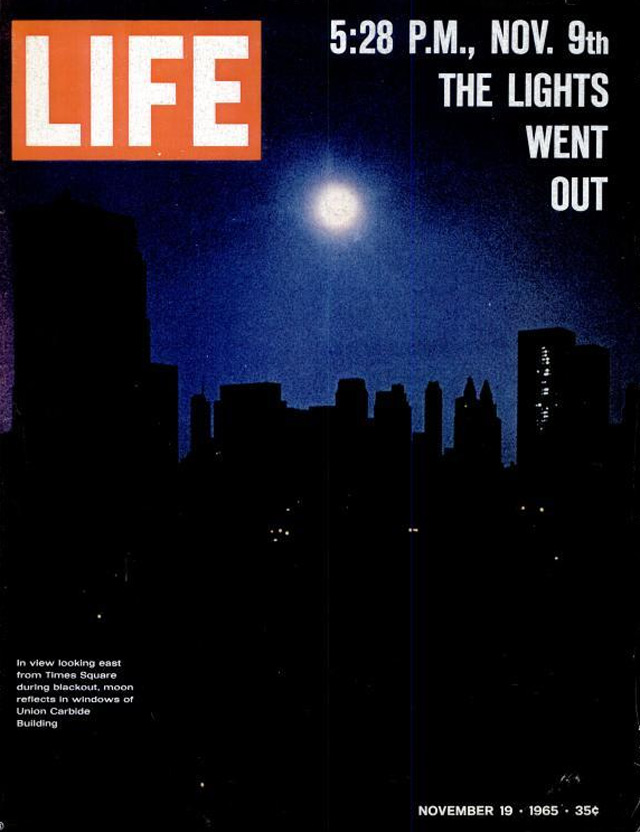
Thanks to overloads affecting plants along the Niagara River that knocked out a cross-border power grid, Torontonians were among the 35 million North Americans affected by a blackout that began around 5:15 p.m. Downtown was hit by three waves of unexpected power losses—the first and longest lasted an hour, followed by a 15-minute outage at 6:55 p.m. and a 20-minute loss at 7:25 p.m. The longest spell of darkness hit North York east of Yonge Street, where the power remained off until 8:25 p.m.
People leaving work downtown were greeted by streets littered with marooned streetcars and trolley buses. Underground, most subway trains were able to coast into the nearest station. For trains stuck in between stations, TTC crews were dispatched to guide passengers out of rear cars toward the nearest station. Despite the delays, passengers remained calm and treated the situation as just another rush hour nuisance. “We just sat there and had a very nice time,” Mrs. W.G. McGowan told the Toronto Star after a two-hour, two-stop ride home. “We all had a good visit with people we didn’t know.” Another passenger admitted to CBC Radio that he “just sat there watching the girls.” While 75 extra buses were pressed into service to replace the Yonge-University line, full TTC service was not restored until 9 p.m.
For those attempting to drive home, the lack of functioning signals created gridlock. With too many busy intersections for Metro Toronto police to handle, citizens took traffic control into their own hands. After witnessing two near-fatalities, teacher-in-training Pat Conroy pulled over at Finch and Willowdale avenues to keep traffic flowing. “I felt somebody had to do something about it,” he told the Globe and Mail. “I kept on wondering where were all the EMO (Emergency Measures Organization, now Emergency Management Ontario) people or the police.” Conroy, who also directed traffic at Bayview and Finch, noticed that police passed by him three times, while a fourth officer warned him not to expect any compensation if he was hit. The following day, police chief James Mackey criticized people who acted like Conroy due to the risks of directing traffic. “We know the civilians were hoping to help,” he told the press. “But many of them were out in those intersections with dark clothing and no lights. It was dangerous.” Mackey’s statements were condemned by EMO officials, who were impressed by the initiative taken by Conroy and others and believed they deserved honours. According to Metro Toronto EMO director J.H. Pollard, “in an emergency it is sometimes necessary to use common sense and to act without legal sanction.”
Confusion also reigned at the airport. Flight dispatch clerk Ivan Matsalla was among the people Telegram reporter Tiny Bennett asked the question “And where were you?”
I was at work at Toronto International Airport and when all the lights went out it seemed rather like fun. When we realized it was a large scale blackout we started to rush around. One of our men phoned in to inform us New York was out and as we had a plane over here we had to hustle. All our phones and radios were out but one phone which really came in for heavy traffic. It wasn’t until the emergency lighting came on that we had the chance to find out just how widespread it all was.
Many commuters unwilling to wade into traffic and transit chaos rode out the blackout by knocking back a drink or two. Despite candlelight illumination and a lack of air conditioning that created thicker-than-usual clouds of cigarette smoke, downtown bars enjoyed brisk business. Thelma Day, hostess of the Cork Room on Bay Street, told the Globe and Mail that “the power can go off at 5:30 every night; it keeps the cash registers ringing.” Day worried about getting more candles and how to send her waitresses home when their shifts ended. “It’s impossible to get a taxi,” she noted. “Maybe some good-looking fellows will come along and drive them home. That’s sweet, isn’t it?” Over at Le Coq d’Or on Yonge Street, manager Nicholas Fotes observed that “none of the customers are panicky—in fact I think they are enjoying it.”
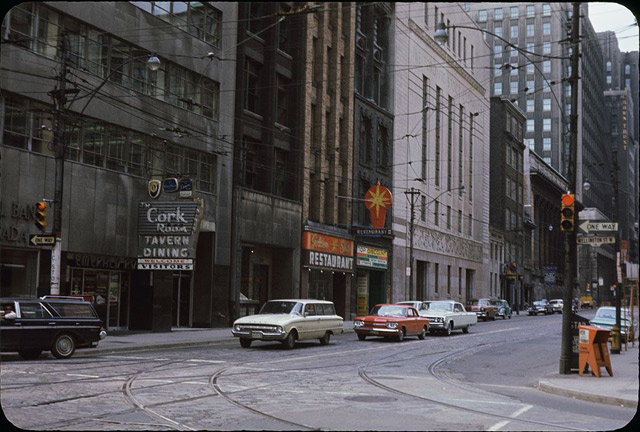
Also enjoying the blackout were 200 children who continued skating in Nathan Phillips Square thanks to a Department of Parks truck which used its headlights to illuminate the rink. Inside the new City Hall, the emergency power was switched on, but not before Mayor Phil Givens’ wife was temporarily trapped in an elevator for several minutes.
Mrs. Givens had a short wait compared to Bathurst Street resident Evelyn Solomons, who was trapped with her two-year old daughter Wendy while riding an elevator up to her second-floor apartment. “My first reaction was one of horror because I didn’t know what happened,” Solomons told the Star. “Then I heard voices saying there had been a power cut.” Her neighbours attempted to open the doors with crowbars before calling the fire department, which arrived just as power returned. When the two-hour ordeal was over, she vowed it would be a long time before her next elevator ride.
Non-functioning electrical doors and equipment were an issue in various places. Supermarket shoppers who waited in line to have their purchases checked by flashlight and rung up by hand were stuck in stores when the automated doors wouldn’t budge. A stranded Ontario Hydro official who asked his wife to pick him up waited over an hour because she had to wait for someone to manually open the garage door of their apartment building. At the Don Jail, electrically operated locks clamped shut for half-an-hour before emergency power kicked in.
Despite the blackout, most large social functions carried on. As the Telegram noted, “no one seemed to care if the female guests turned up with smeared lipstick or the men wore mismatched socks.” Actors rehearsing a play at the Poor Alex Theatre tossed aside scripts they couldn’t read and improvised their lines, which they felt improved their performance. Restaurants with gas stoves continued to serve customers, with some take-out counters reporting a 40 per cent increase over usual Tuesday night sales due to people who couldn’t cook at home. For families who could, there was the option of pulling their barbecues out of storage, allowing kids to enjoy a late-season grilled hot dog. Boiling frankfurters or other edibles over a fire wasn’t an option for some homeowners, especially in Scarborough and North York, as the outage knocked out water pumping stations, leaving residents in areas where pumps lacked backup power with little-to-no water pressure.
Finding the latest updates about the blackout was a tricky matter. In his review of local radio coverage, Telegram entertainment editor Jeremy Brown found CFRB was the best source of information, as the station “answered every question that came to my mind, in a relatively dispassionate, full, responsible manner. CFRB’s backup power kicked in with barely a disruption to its signal, and its traffic reporter Eddie Luther quickly surmised from his helicopter that the power outrage wasn’t an isolated incident. Telegram television columnist Bob Blackburn found coverage from the United States was stronger than that found on local stations—CBC ran a pair of bulletins, while CFTO preferred to scroll information across the bottom of the screen than interrupt regular programming.
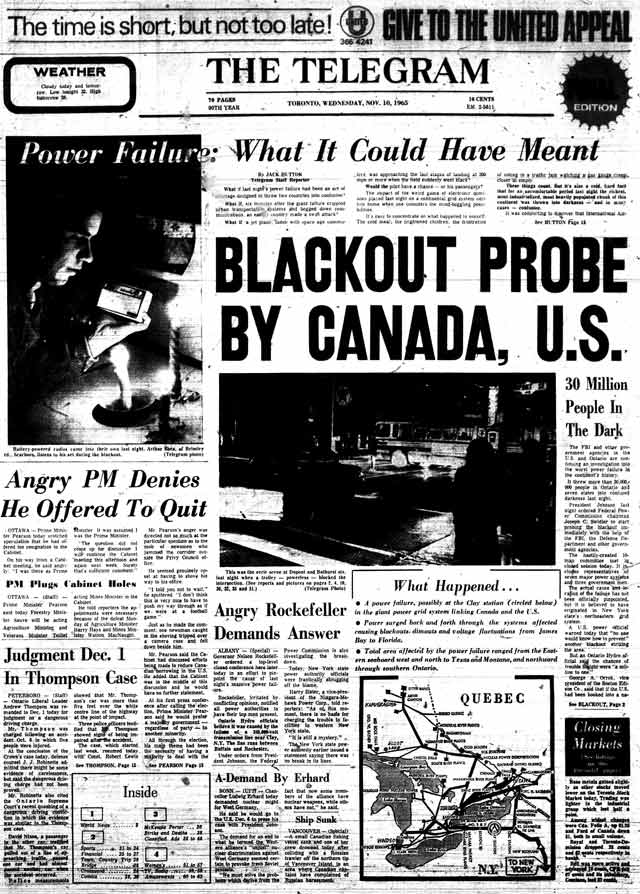
In the days that followed the blackout, government officials on both sides of the border wanted to determine who to pin the blame on. Ontario Hydro found their American counterparts tight-lipped about their initial investigations, which led to Ontario Premier John Robarts musing about cutting ties to the American power grid if remaining connected would lead to future problems. Robarts might have wished he had kept his mouth shut when Ontario Hydro admitted during a November 15, 1965 press conference that, ironically, measures it had installed to prevent a mass blackout had initiated the outage. On the bright side, Ontario Hydro chairman W. Ross Strike noted that the incident was a blessing in disguise—“We’ve been alerted that further study is needed so that maximum safety can be developed.” While preventative measures were put in place to prevent another blackout on the same scale, we know based on what happened in the summer of 2003 that they haven’t always worked.
Sources: the November 10, 1965, November 11, 1965, November 13, 1965, and November 16, 1965 editions of the Globe and Mail; the November 10, 1965 and November 16, 1965 editions of the Toronto Star; and the November 10, 1965 edition of the Telegram.
Top photo: The Telegram, November 10, 1965
Historian Jamie Bradburn will be sharing a selection of his columns from the now-defunct Torontoist publication. You can subscribe to his substack newsletter at jamiebradburn.substack.com

